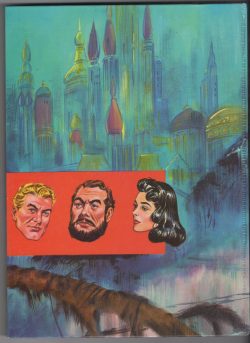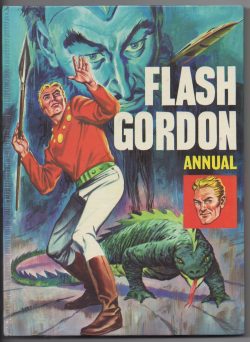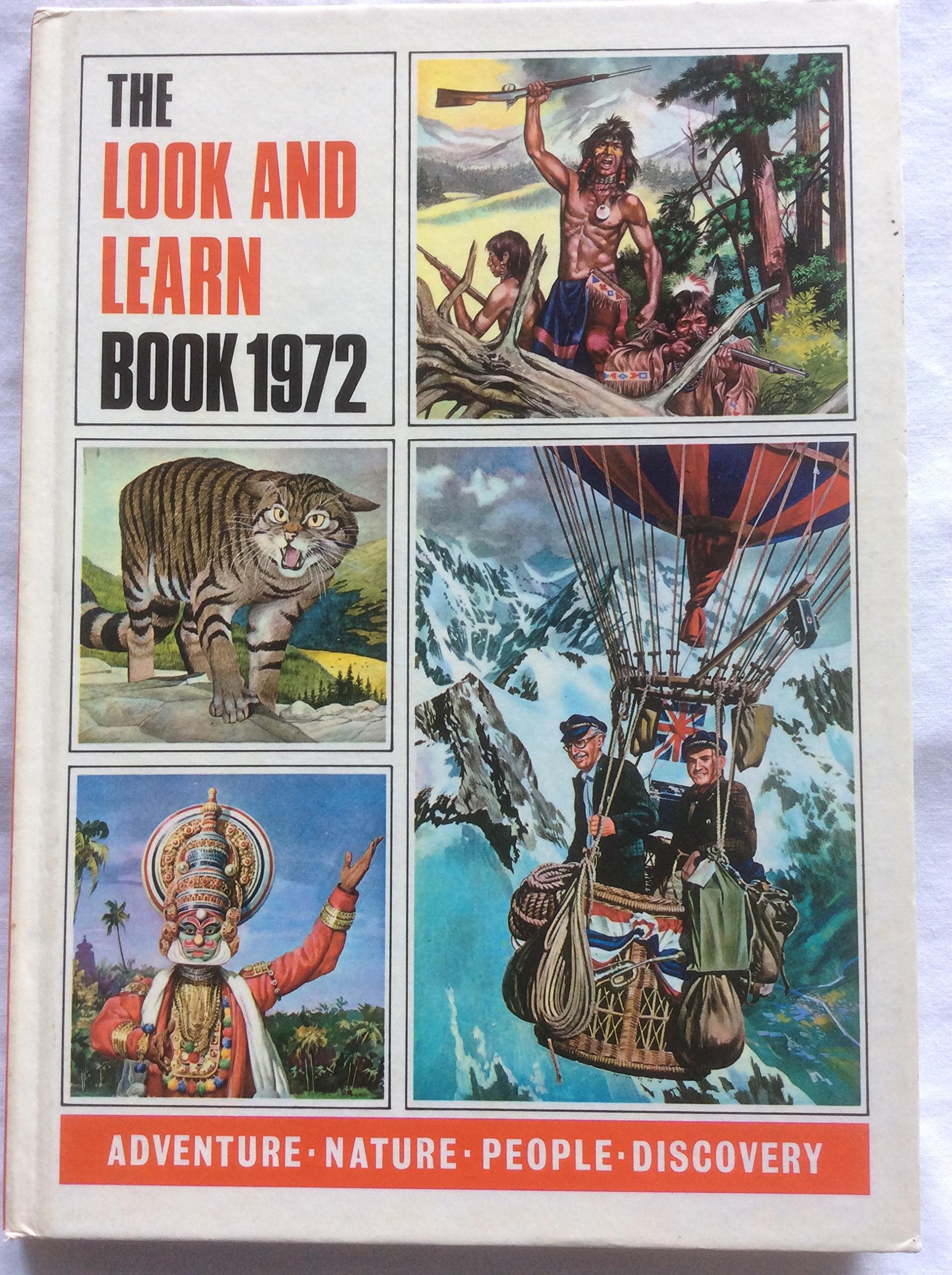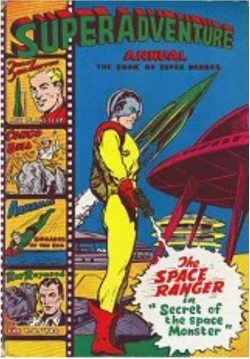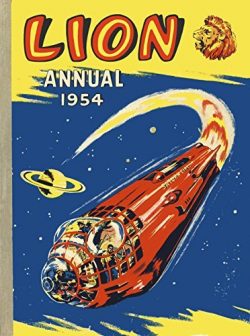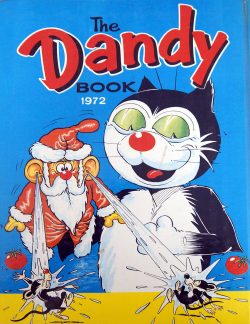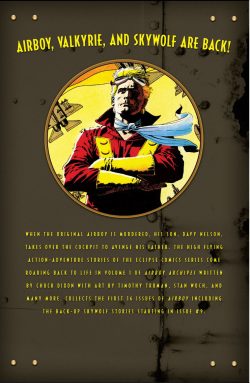
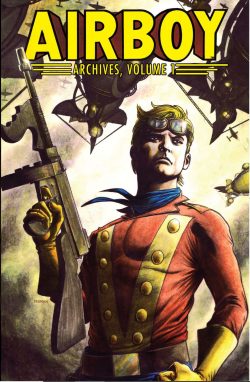
By Chuck Dixon, Tim Truman, Stan Woch, Benn Dunn, Bill Jaaska, Tom Lyle, Larry Elmore, & various (IDW)
ISBN: 978-1-61377-900-2 (TPB) 978-1-62302-641-7 (IDW Digital edition)
Airboy was one of the very best adventure strips of the Golden Age: one with a terrific pedigree and a profound legacy. Created for Hillman Periodicals by the brilliant Charles Biro (Steel Sterling, Crimebuster, the original Daredevil, The Little Wiseguys and landmark genre prototype Crime Does Not Pay number among his many triumphs), it featured a plucky teen and his fabulous super-airplane, affectionately dubbed “Birdie”.
Airboy and Birdie both debuted in the second issue of Air Fighters Comics, cover-dated November 1942 (so Slightly Belated Happy Birthday guys!). The title was packed out with similarly-themed and oddly off-kilter aviator heroes such as Skywolf, The Iron Ace, The Black Angel, The Bald Eagle, The Flying Dutchman, The Flying Fool and a landmark horror proto archetype dubbed The Heap – forerunner of all comic muck monsters…
In December 1945, and after 23 issues, the title was redesignated Airboy Comics and soldiered on until 1953, when Hillman with great foresight got out of the funnybook biz just as hostile clouds of censorship were gathering. In over a dozen years of publication, the boy-warrior had tackled the Axis powers, crooks, aliens, monsters, demons and every possible permutation of sinister threat and horror-tinged terror – even subversive giant rats and conqueror ants!
The gripping scripts – initially the work of Biro and Dick Wood before the latter assumed complete control – took the avenging aviator/soldier-of-fortune all over the world to confront some of the most striking adversaries in comics and often some of the sexiest. The most notable of these was undoubtedly the conflicted Nazi Air Ace known as Valkyrie, who flew the killer skies with a squadron of lethal lovelies codenamed The Airmaidens.
However, as the world and tastes changed, Airboy vanished with many other gaudy comic book champions whose time had run out. Clearly, memories remained fresh for many, no doubt rekindled by a superb popular history series in the early 1970s. The Steranko History of Comics and its effusive chapter on the lethal lad led to a speculative venture reprinting two issues of the early run.
Airboy was also the inspiration for Jetboy – originating lynchpin of the Wild Cards franchise by Howard Waldrop, George R.R. Martin, Melinda M. Snodgrass and their many friends. That began in January 1987 and is still going strong with 30 books as of 2022…
In 1982 comics devotee and champion archivist Ken Pierce had collected early Airboy exploits featuring the voluptuous, absurdly pneumatic Nazi-turned-freedom-fighter Valkyrie, and this apparently inspired budding independent comics company Eclipse to reboot and revive the character …and many of his Hillman comrades.
Always innovative, Eclipse were experimenting at that time with fortnightly (that’s twice a month, non-Brits) comics with half the page count of industry standard books, but at a markedly reduced price. To be honest, at 16 pages of story per issue, it wasn’t that different from the 17-18 pages Marvel and DC had been reduced to working with during the late 1970s…
Airboy premiered at 50¢ a copy in July 1986 and quickly found a vocal, dedicated following. Rereading – in either trade paperback or digital editions – this first archival compilation, it’s easy to see why…
Collecting Airboy #1-16 spanning July 15th 1986 February 27th 1987, this superb, so very Eighties all-action romp opens with a revelatory Introduction by instigator and near-exclusive scripter of the entire resurrected franchise Chuck Dixon who asks and answers ‘Why Airboy?’: detailing the events that led to all-star packager/indie maverick Tim Truman getting involved with one of the biggest and most influential series of that era. With Dixon scripting, Truman co-plotting, editing and pencilling, Tom Yeates inking, Tim Harkins lettering and Ron Courtney applying a then-radical colour palette, the initial 5-issue story arc (collected in 1989 as graphic novel Airboy: The Return of Valkyrie) explodes into action…
Issue #1 begins ‘On the Wings of Death’ as, in California’s Napa Valley, a broken man rails against an unjust fate. David Nelson II is bitter and angry. Not even his teenaged son can bring joy to his life. The boy barely knows and certainly has no warm memories of his dad: an aviation magnate who switched from building civilian planes to forging deadly high-tech weapons for any dictator to buy…
Trained since birth by former Japanese WWII fighter ace and deadly martial artist Saburo Hirota, young Davy has become a brave, confident fighter who cannot imagine why his life has been one of constant combat training.
Suddenly, a horde of assassins attacks the compound and the senior Nelson dies in a hail of bullets. Only then does Davy discover the truth about his father. Once upon a time, the aloof martinet was war veteran and roving hero Airboy: battling against and alongside valiant comrades and piloting a truly unique super-aircraft. Second feature ‘Phoenix’ sees the aging samurai tell of the lost hero and – armed with the truth – Davy Nelson III swears to avenge his father and atone for his own inactions and neglect…
Two weeks later, ‘The Wolf and the Phoenix’ reintroduces WWII legend Skywolf who tangentially enters the saga whilst clearing out South American drug traffickers who have been using his isolated Florida Keys island/US military dump for decommissioned ordnance as a staging post for their enterprise. When Hirota and the kid turn up, it’s not just to share the news of a fallen comrade, but also to reclaim and rebuild the shell that used to be Birdie…
As they reassemble and modify the super plane, stories are told and Davy discovers another shocking truth. His mother was not his father’s true love. Once he loved a beautiful German woman-warrior named Valkyrie. However, for the last thirty years she has been trapped in suspended animation by Misery, a phantasmal being who feeds on evil and steals the souls of lost fliers…
Forced to do the monster’s bidding for three decades – such as providing weapons for South American despots to slaughter and enslave innocents – the old hero had gradually died inside. Now his son is ready to avenge him and free the beautiful sleeper. Soon Skywolf’s drug-dealer problem are connected to the death of the original Airboy, leading them all to tropical Bogantilla and despotic General Orista – one of Nelson Aviation’s biggest customers and a staunch anti-Communist whose regime is proudly supported by the Reagan Administration…
With #3’s ‘Misery Loves Company’, Willie Blyberg began inking Woch as – after a tragic and costly misunderstanding – the reunited Air Fighters ally with rebels resisting Orista’s depredations. It’s been a hard struggle as the dictator army is fully supplied with Nelson’s armaments, backed up by black magic. Ghastly Misery has been extorting the ordnance from his arch foe by threating to kill the comatose Valkyrie: a process that had slowly poisoned the heart and crushed the soul of Davy’s dad. Now, however, the tide is turning…
Months previously, from deep in the Florida Everglades the monstrous bog-creature known as The Heap stirred after decades of inactivity. Something momentous was beginning to unfold and – vaguely remembering a previous life, brave heroes and a diabolical evil – it began shambling southwards…
Now the rebels and yanqui heroes raid the General’s citadel in Gamada Cruz, assisted by the Heap and a local shaman, triumphantly completing their ‘Assault on Villa Miserio’ by rescuing the dormant sleeping beauty, weaking bloody vengeance on Orista and driving off the immortal emotion vampire behind all the death and destruction in concluding chapter ‘Misery Takes A Holiday’ (illustrated by Woch, Blyberg & Emil Novak). Not all the good guys make it back, and most uncomfortably of all the revived captive is unaware that the hero she tries so passionately and amorously to reward is not “her Davy”…
Fast-paced, beautifully illustrated and written with all the gung-ho bravado of a Rambo movie, this tale of liberation and revolution rattles along, a stirring blend of action and supernatural horror that sweeps readers along with it, setting the scene for a tense confrontation in #6 as ‘Back in the USA’ covers the aftermath wherein the time-displaced “aviatrix” seeks to adjust to a strange and frustrating new world and form some kind of relationship with the son of her lost lover…
Hirota leaves them to it: he’s more concerned with another long-term rehabilitation project: helping an old ally from WWII with very different yet eerily similar problems. Davy is trying to cleanse his corporation of the last taint of scandal and corruption only to discover that – thanks to CEO Emil Kronenberg – it has been happily supplying appalling weapons and support to almost every gang, terror group and corrupt regime on the planet. He has no idea that other eyes are upon the aging European: hungry, implacable, vengeful ones…
In #7, Valkyrie accepts a vast wad of cash and heads to New York City to lose herself in hedonism. Inked by Jeff Butler, ‘Partytime’ then sees Davy ambushed by his entire complicit Board and abducted by Kronenberg who resumes the indoctrination experiments he devised back in the camps in Germany. Unluckily for him, whilst losing herself, Valkyrie has impossibly found an old friend from the War who also has not aged a day…
Fellow former Luftwaffe pilot Baron Victor Heller has his own magical secrets to keep but makes a useful ally once Davy’s disappearance galvanises Hirota to enlist Val’s assistance in finding the boy…
Davy’s in big trouble in #8 (illustrated by Woch & Blyberg with colours from “Air Rescue”), trapped ‘Down in the Darkness’ and tortured. The extreme hostile takeover move proves initially unsuccessful and as the next issue hikes the price up to $1.25 and extends the page count, ‘Body Count!’ sees his friends move in for a savage showdown.
Inked by Mark Nelson & coloured by Moondoggies, it was offset by a new back-up series exploring the post war career of Skywolf and other Golden Age Air Fighters characters. Concluding in the next issue, ‘China Hands’ by Dixon, Larry Elmore, Harkins & Steve Oliff/Olyoptics, is set in 1948 as China falls to communist control. Here Link Thorne – AKA The Flying Fool – ferries food and medical supplies to the simple peasants caught up in the political carnage, only to be framed by US spook Jensen of what will become the CIA and imprisoned by Chang Kai Shek’s Nationalist army.
Desperate to help, American freight company owner Riot O’Hara reaches out to aimless drifters Skywolf to spring Thorne. Their rescue attempt is sabotaged by agents of the American government and officially they all die in the attempt… Officially…
With John Nyberg inks, #10 concludes Davy’s rescue and sees Kronenberg at last get what’s coming to him in ‘Tooth and Claw’, even as ‘China Hands part 2’ reveals how Skywolf became the man of mystery we all know and love…
Airboy #11 was written by Truman, with art from Ben Dunn & Hilary Barta. ‘…I Am Birdie’ peers into the past and retells the origin of David Nelson II and his sentient wonder craft whilst Dixon & Bill Jaaska combine for another historical 2-parter starring Skywolf. Set in 1949, ‘I Don’t Need My Grave!’ (with the concluding chapter inked by Jeff Darrow) sees the masked wanderer in Tokyo, resolved to stop criminal upstart Billy Yee, strongarming Riot O’Hara.
Yee wants her to export his drugs to America, but as “sangokujin” (displaced Korean or Chinese foreigners) must work outside Japan’s established criminal hierarchy. That’s proved when Skywolf’s attack is interrupted by members of the Yamataki syndicate and before long Yakuza and Yankee outlaw are united in the same goal. All they have to do is deal with the US soldiers Jensen has set on their tails and it’s clear sailing from then on…
The Airboy story in #10 had ended with a portentous teaser as an aerial assault force devastated Skywolf’s Florida island retreat in 1985. Leading the raid was a bloodthirsty loon dubbed Manic. The saga properly kicks off in #12’s ‘Gone to Texas’ (by Dixon, Woch, Kim DeMulder), as – whilst Hirota counsels former ally The Iron Ace (angrily trapped inside the world’s most advanced full body prosthesis) – Davy and Valkyrie tentatively explore their new normal. Both are understandably disturbed by the thought of renewing her relationship by proxy, switching her avid affection from father to son, but thankfully Skywolf distracts them with his latest problem…
Amidst the rubble of his home is a message from his unseen enemies: the burned body of a cop from the banana republic of the Grand Coronicos Islands…
A hastily arranged meeting brings Davy and Hirota to Galveston, Texas and a frankly hilarious encounter with Skywolf’s older, smarter, tougher, wheelchair-bound mother. She thinks her boy’s an idiot and refuses to call him anything but “Lawrence”, but her advice is welcome and leads to Nelson Aviation fronting Skywolf a new top-of-the-line helicopter gunship for their upcoming visit to the Grand Coronicos…
In #13 Dixon, Woch, Nelson & Steve Haynie craft a chilling ‘Tag-Team’ as Manic and his psycho partner Cowgirl apprise their boss of the situation. The nation is supposedly ruled by avid anti-Communist El Presidente Generalissimo Valasquez, but it’s his wife who has really pulled the strings for much of the last 50 years. The methodical scheme to corner America’s entire drug trade is hers, but that starts unravelling as soon as Davy and Birdie start shooting down drug-filled cargo planes…
The response is swift and savage and teams are despatched by Manic to kill everyone close to Nelson and Skywolf. Of course no drug cabal assassin is a match for Hirota, Valkyrie or Lawrence’s mom…
The drama intensifies in ‘A Barrel Full of Sharks’ (Woch & Nelson) as the intended victims all converge on the Islands for a little payback…
Airboy #13 & 14 also offer a fantastic history mystery by Dixon, Tom Lyle & Romeo Tanghal, as ‘Queen of Yeti Valley’ reveals how Skywolf and the Bald Eagle unite to exfiltrate the British Ambassador’s daughter in the Himalayas and end up saving a lost race from human monsters…
In 15 & 16 the posterior back-ups see supposedly deceased Skywolf sneak back into Texas in 1950 for ‘White Lightning’ (Dixon, Woch & Vern Henkel). Happily anonymous, the outlaw says hi to his ma and puts paid to a preacher opening up a Ku Klux Klan franchise to deal with all them uppity, invasive Mexicans in a deeply satisfying and cathartic dose of bigot-trashing catharsis…
At the fronts and in the Eighties, Airboy and his crew go undercover to infiltrate Puerto Oloroso, poverty stricken capital of the Grand Coronicos Island Chain, inevitably unleashing a ‘Caribbean Rampage’ over the final two episodes in this spectacular opening compilation. By scuttling the scheme to flood America with cut-price coke, Airboy, Hirota, Valkyrie and Skywolf (and his mom) achieve a brief moment of pure Eighties synergy: marrying style, outrageous fashion, ostentation, Contras, drugs, the CIA and always over-the-top action with a spurious motive, and wicked humour in a high octane romp translating the fighting stars of WWII to the era of Airwolf, Nightrider and Miami Vice.
Including stunning covers by Truman, Woch, Dave Stevens, Tex Blaisdell, Paul Gulacy, Flint Henry, Howard Bender, Yeates, John Totleben. Davis Dorman and Ron Randall, this is a true lost delight of sheer escapism well worth tracking down, with the promise of more and even better still to come.
Airboy Archives volume 1. Airboy © 2014 Chuck Dixon. © 2014 Idea and Design Work’s LLC. All rights reserved.




